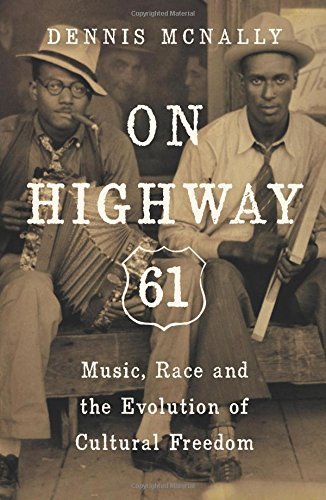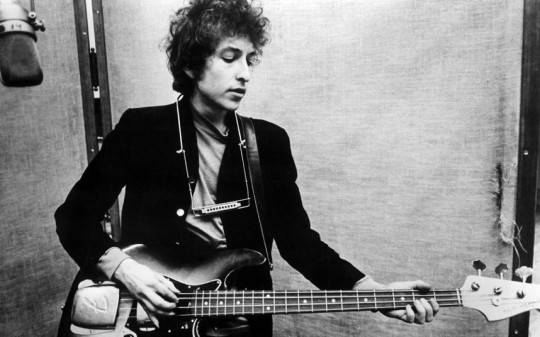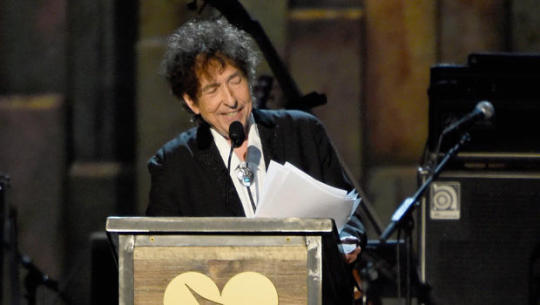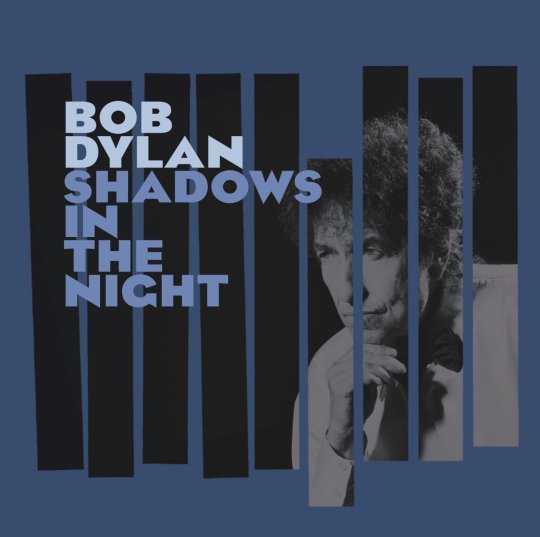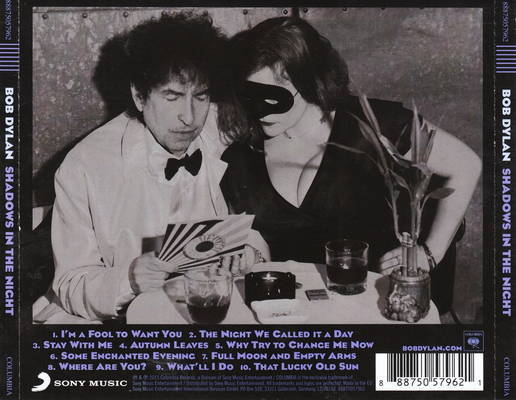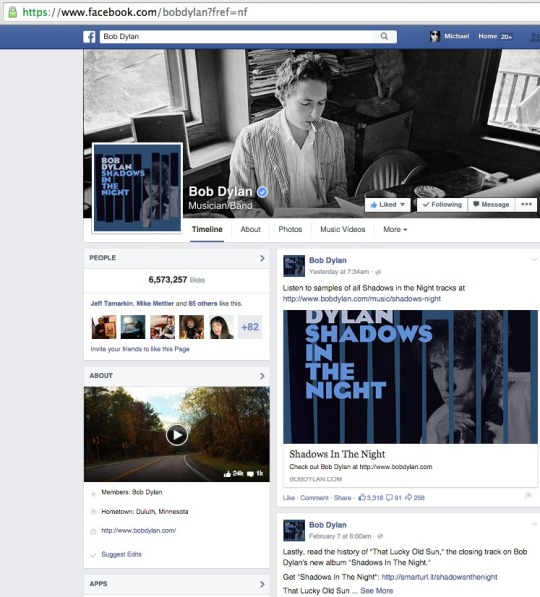
On Bob Dylan’s Facebook page, info about the songs he covers on Shadows In The Night has been posted.
Here are excerpts from what’s there so far with links to each entire post:
I’M A FOOL TO WANT YOU
Song written in 1951
Joel S Herron, Frank Sinatra, Jack Wolf
COVERS:
Many came to know the song from Billie Holiday’s last sessions for Columbia Records, Lady in Satin, released in 1958. Also recorded by Chet Baker, The Four Freshmen, Billy Eckstine, Sergio Franchi, Sammy Davis Junior, Helen Merrill, Dinah Washington, Dionne Warwick, Robert Goulet, Tony Bennett, Shirley Bassey, Hadda Brooks, Peggy Lee and Steve Lawrence.
Joel Herron was the musical director of the famous Copacabana nightclub during the 1940s. He also was a pianist, arranger and accompanist. Lyricist, Jack Wolf was a close friend. Herron had been using Brahms’ Third Symphony as his theme song at the Copa, when Wolf suggested using the Andantino section from the same symphony as a melody for a song. Together they created a composition that Frank Sinatra recorded in 1950, entitled TAKE MY LOVE. Released as a single during 1951, a low point in Sinatra’s recording career, TAKE MY LOVE failed to chart. At that time, Mitch Miller, who was the head of A&R at Columbia Records had lost faith in Frank’s ability to sell records. Indeed, many consider the absolute nadir in Sinatra’s career was when Miller forced him to record the novelty song, MAMA WILL BARK. Ironically, eleven short years later Miller also showed complete indifference to John Hammond’s new signing to Columbia Records, Bob Dylan…
Read more here.
The Night We Called It a Day
Song written 1941
Matt Dennis, Tom Adair
COVERS:
Doris Day, Chris Connor, June Christy, Chet Baker, Diana Krall, The Hi-Lo’s, Frank Sinatra.
Matt Dennis was a singer, pianist, bandleader, arranger and songwriter. Born in Seattle to a musical Vaudevillian family, he formed his own band in the mid-30s with Dick Haymes as vocalist. Dennis also worked as vocal coach and arranger for big band singers and popular recording artists including Martha Tilton and Jo Stafford. When Stafford joined the Tommy Dorsey Band in 1939, she persuaded Dorsey to hire Dennis as an arranger. Along with lyricist Tom Adair, Dennis wrote fourteen songs in one year alone including EVERYTHING HAPPENS TO ME – a hit for the band with lead vocalist Frank Sinatra…
Read more here.
STAY WITH ME
Song written in 1963
Carolyn Leigh, Jerome Moross
COVERS:
The song is best known as its alternate title, “Theme Song from The Cardinal,” as sung by Frank Sinatra. The Cardinal was a 1963 Otto Preminger film which follows the journey of a young Boston priest as he climbs the hierarchy of the Catholic Church during the rise of Fascism in Europe.
Carolyn Leigh was a New York born lyricist who wrote for Broadway, movies and popular music. After graduating New York University, Leigh began her career as a copywriter for radio stations and advertising agencies. She transitioned to writing lyrics for Broadway musicals including “Peter Pan,” “Wild Cat,” ” Little Me” and “How Now Dow Jones.” Her biggest successes came in partnership with Cy Coleman in the early 60s. Together they penned such notable hits as, WITCHCRAFT, HEY LOOK ME OVER, and THE BEST IS YET TO COME…
Read more here:
AUTUMN LEAVES
Song written in 1945, English lyrics written in 1947
Joseph Kosma, Jacques Prevert , Johnny Mercer
COVERS:
Jo Stafford, Edith Piaff (in French), Tom Jones, Mel Torme, Sarah Vaughn, Nat King Cole, Bing Crosby, Frank Sinatra, Paul Anka, Tony Bennett, Louis Prima. The song has long been a favorite of jazz musicians with over 1400 cover versions from Paul Whiteman, to Ben Webster, to Cannonball Adderly, Bill Evans, Charles Lloyd and Coleman Hawkins.
Joseph Kosma was born in Budapest in 1905. A musical prodigy, he began piano lessons at age 5 and composed his first opera at age 11. He studied at the Liszt Academy with Bela Bartok. He emigrated to Paris in 1933 where he met poet and screenwriter Jacques Prevert, who in turn introduced him to filmmaker, Jean Renoir. During World War II, Kosma was placed under house arrest and was banned from composing music. However, Prevert arranged for him to continue composing for films using other musicians as a front. It was in this way that he wrote the music for Les Enfants du Paradis (Children of Paradise) in 1945. His other film credits include La Grand Illusion (1937), La Bete Humaine (The Human Beast) (1938) and La Regle du Jeu (The Rules of the Game) (1939) all directed by Jean Renoir. Although he did not write many songs he is legendary for composing the melody to the Jacques Prevert poem Les Feuilles Mortes, which would eventually become Autumn Leaves…
Read more here.
Why Try To Change Me Now
Song written in 1952
Cy Coleman, Joseph Allen McCarthy
COVERS:
Frank Sinatra had the first recording. Other covers include Sammy Davis Jr., Fionna Apple, Jimmy Scott, and Nancy Wilson.
Born Seymour Kaufman in The Bronx in 1929, Cy Coleman was a composer, songwriter and jazz pianist. He was a child prodigy who gave piano recitals at Town Hall and Carnegie Hall between the ages of 6 and 9. Prior to beginning his Broadway career he led a trio which became a successful nightclub attraction. Success on Broadway first came as a composer in collaboration with Joseph McCarthy, Jr. But his biggest successes started in 1960 once he paired with lyricist Carolyn Leigh. Together they wrote WITCHCRAFT and THE BEST IS YET TO COME, HEY LOOK ME OVER, among many others…
Read more here.
Some Enchanted Evening
Song written in 1949
Oscar Hammerstein II, Richard Rodgers
COVERS:
Bing Crosby, Barbara Streisand, Al Jolson, Andy Williams, Jo Stafford, Perry Como, Ezio Pinza, Harry Connick, Jr., Art Garfunkel, Jay & the Americans, Frank Sinatra.
From the musical South Pacific, SOME ENCHANTED EVENING is considered the single biggest popular hit to come out of any Rodgers and Hammerstein show. In the original Broadway Production, the song was sung by former Metropolitan Opera bass, Ezio Pinza.
Oscar Hammerstein was born in New York City in 1895, the grandson of a Jewish theater impresario. His father was a Vaudeville theater manager and producer. He attended Columbia University and studied at Columbia Law School, but would soon quit the study of law to pursue theater. For the next 40 years he would be one of the most successful and prolific lyricist and theatrical producers of musicals in America…
Read more here.
FULL MOON AND EMPTY ARMS
Song written in 1945
Buddy Kaye, Ted Mossman
COVERS:
Robert Goulet, Sarah Vaughn, Jerry Vale, Eddie Fisher, Donna Brooks. Best known version is by Frank Sinatra.
This song is based on Sergei Rachmaninoff’s Piano Concerto No.2, written between 1900 and 1901. It became Rachmaninoff’s most popular composition and built his reputation as a concerto composer. Born to an aristocratic family in Russia in 1873, Rachmaninoff’s first success came as a pianist – giving his first concert by the age of nineteen. In that same year he composed and performed an opera based on a poem by Alexander Pushkin, which became an immediate success in Moscow. The Russian Revolution forced him to leave the country in 1917. Eventually he emigrated to the United States in 1918 after receiving several lucrative performance offers. He supported himself and his family as a world renown concert pianist until his death, in Beverly Hills, in 1943…
Read more here.
Where are You?
Song written in 1937
Harold Adamson, Jimmy McHugh
COVERS:
Mildred Bailey, Chris Connor, Shirley Bassey, Aretha Franklin, Brenda Lee, Julie London, Frank Sinatra, Dinah Washington.
Jimmy McHugh was one of the most prolific songwriters from the 1920s through the 1950s. Born in Boston in 1894, McHugh struggled in a variety of odd jobs including work as a rehearsal pianist at the Boston Opera House and as a pianist/song plugger for Irving Berlin’s music publishing company. At the age of 26, he relocated to New York City, finding work as a song plugger with the Jack Mills publishing company. It was there that he teamed up with future Duke Ellington manager Irving Mills to form the Hotsy Totsy Boys, writing and recording their hit song, EVERYTHING IS HOTSY TOTSY NOW…
Read more here.
What’ll I do?
Song written in 1923
Irving Berlin
COVERS:
Julie London, Anne Murray, Lou Rawls, Rosemary Clooney, Nat King Cole, Chet Baker, Cher, Perry Como, Tommy Dorsey, Judy Garland, Dinah Shore, Eydie Gorme, Linda Ronstadt, Sarah Vaughan, Paul Whiteman, Lena Horne, Alison Krauss, Dick Haymes, Georgia Gibbs and Alvin and the Chipmunks.
Born in Russia in 1888, Berlin was one of eight children. His father was a cantor in a synagogue who uprooted the family in 1893 and moved to New York in order to escape the Russian pogroms against Jews so rampant in Eastern Europe. They settled on Cherry Street on the Lower East Side in a cold water basement flat with no windows. His father, unable to find work as a cantor, labored at a meat market and gave Hebrew lessons on the side. He died when Irving was thirteen years old. With only a few years of schooling, Irving found it necessary to take to the streets to help support his family. His first job was as a newspaper boy – hawking the Evening Journal. Meanwhile the rest of the family scrounged for work; his mother as a midwife, his three sisters wrapping cigars in a factory and his older brother assembling shirts in a sweatshop…
Read more here.
That Lucky Old Sun
Song written in 1949
Haven Gillespie, Beasley Smith
COVERS:
Biggest hit version was by Frankie Lane, which reached number one in 1949. Other chart hits were by Vaughan Monroe, Louis Armstrong and Frank Sinatra, all in 1949. Other covers include Ray Charles, Dean Martin, Leon Russell, Johnny Cash, Aretha Franklin, Willie Nelson, The Isley Brothers, Pat Boone, Sarah Vaughan, LaVerne Baker, Sammy Davis Junior and Bing Crosby…
Read more here.
-– A Days of the Crazy-Wild blog post: sounds, visuals and/or news –-
—
[I published my novel, True Love Scars, in August of 2014.” Rolling Stone has a great review of my book. Read it here. And Doom & Gloom From The Tomb ran this review which I dig. There’s info about True Love Scars here.]
Like this:
Like Loading...
